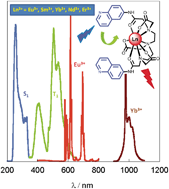In order to evaluate quinoline as a remote sensitiser, we have prepared a DTPA based ligand, H33L, bearing quinoline bisamide arms for the complexation of a range of lanthanide(III) ions to give the neutral complexes LnL where Ln3+ = Y3+, Eu3+, Sm3+, Tb3+, Er3+, Yb3+, Nd3+, Gd3+. Detection of the phosphorescence signal exhibited by the GdL complex at 77 K confirmed that the triplet energy level of the sensitiser at 21 190 cm−1 was suitable for the indirect population of a range of lanthanide luminescent states. A full photophysical analysis of the complexes reveals that SmL and EuL display red emission when excited through the ligand-based absorption band centred at 330 nm, extending the excitation to violet light around 370 nm. We demonstrate that quinoline sensitizes near-infrared emission in the YbL, ErL and NdL complexes, in powder form as well as in solution. Most importantly, the luminescence for YbL and NdL was sufficiently efficient to be detected in non-deuterated solvent.
You have access to this article
 Please wait while we load your content...
Something went wrong. Try again?
Please wait while we load your content...
Something went wrong. Try again?


 Please wait while we load your content...
Please wait while we load your content...